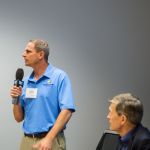Original Article via Mike Sunnucks, Phoenix Business Journal
It’s easy to peg downtown Phoenix as the Valley’s geographic and business center. It is home to office towers, big banks, corporate law firms and traditional seats of power.
The mayor of Phoenix, chief executive of the Arizona Public Service Co., the state’s largest utility, and managing partner of the Snell & Wilmer LLP law firm all work downtown. The governor of Arizona is just down the street.
Arizona State University’s downtown campus, Metro light rail and new apartments have given the area a distinctly urban vibe.
But times have changed — and perhaps the location of the Valley’s central core has changed along with it.
Real estate brokers, developers and those in the technology sector say they see the bulk of new jobs, developments and overall business activity centered on Tempe first, then Scottsdale and Chandler.
“The epicenter is at the (Loop) 202 and downtown Tempe,” said Kevin Calihan, senior vice president for the CBRE Group Inc. commercial real estate firm.
Calihan argues Tempe — followed by Scottsdale and Chandler — are where almost all of the big technology and office deals have been happening. He’s not alone in looking east for where the jobs, construction cranes and business locates are landing as the region dusts off from the last real estate crash.
“Tempe especially has been on fire with new technology and financial services-related deals in the office market,” said Jeff Conrad, a principal with Lee & Associates Commercial Real Estate Services.
Tempe Mayor Mark Mitchell said the city soon could announce another 3,000 jobs from financial-sector companies in the coming weeks.
“We’ve been a hotbed for that,” said Mitchell, referring to ADP and Northern Trust landing in Tempe. The mayor said he couldn’t disclose the names of those new companies.
Real estate drivers
The numbers of real estate development and leases make a good case for Tempe as the center of the Valley’s new economy.
Tempe and the East Valley accounted for 59 percent of the 3.14 million square feet of office leasing last year, according to commercial real estate firm JLL. Put Scottsdale in the mix and the east side totals 81 percent of the office activity.
Office leases mean companies moving here or adding space, which equals jobs. That translates into services, restaurants and stores.
“The hottest retail submarket in metro Phoenix in 2016 was the East Valley, in particular Tempe and Chandler,” said Lane Neville, senior vice president with the NAI Horizon commercial real estate firm.
During 2016, retail leasing activity in the East Valley totaled 1.25 million square feet of the 2.16 million-square-foot regional total. That represented about 58 percent of all the retail spaces absorbed in the market, Neville said.
Thomas Brophy, director of research firm ABI Multifamily, said Chandler, the southern part of Tempe and north Scottsdale were the three hottest local areas for apartment complex sales in 2016. They accounted for a combined $1.4 billion in sales.
While there have been new housing starts in the Northwest Valley, heat maps show the bulk of new residential building happening in the Southeast Valley, according to both Greg Vogel’s Land Advisors Organization and Scottsdale-based RL Brown Housing Reports.
Demographics favor growth
The East Valley also has workforce advantages over the rest of the region. Scottsdale, Chandler, Tempe and Gilbert have higher percentages of college-educated workers than most of the West Valley and Phoenix citywide, according to U.S. Census Bureau data.
That translates into site-selection advantages when companies look for skilled and educated workers.
Naomi Johnson, spokeswoman for State Farm, said the company likes being next to Arizona State University’s main campus, Tempe’s access to light rail and its amenities. The Marina Heights development is near Tempe’s Mill Avenue as well as Tempe Marketplace and it’s on Tempe Town Lake. Mountainside Fitness is opening a gym at the Marina development.
“We chose environments that may be attractive to our current employees who may decide to relocate to these areas,” said Johnson. “We know this area is growing and vibrant, and we can attract and retain top talent here.”
ASU not only offers potential employees to State Farm but also offers existing ones chances of continuing education.
Many big recent job announcements — Zip Recruiter, ADP, Orbital ATK, Freedom Financial Network, Endurance International and McKesson Corp. — were for the east side of town.
“I just saw 900 jobs new jobs announced in Tempe the other day,” said David Krumwiede, executive president of Lincoln Property Co., which is developing the Grand at Papago Park Center in Tempe as well as new buildings at the Mesa Riverview development. SAP America Inc. is moving 250 jobs to the new Papago development from Scottsdale, Krumwiede said.
Krumwiede and ABI’s Brophy do see job gains in north Phoenix’s Deer Valley area and near long northern stretches of Interstate 17.
“The area has witnessed some 2,000-plus job announcements, including Farmers Insurance $24 million regional headquarters development,” Brophy said.
Technology history
The East Valley, in particular Chandler, also has a long history with technology via Motorola Inc. and now Intel Corp. Apple Inc. has a big data center in Mesa and could bring server assembly to the East Valley after buying a failed First Solar factory in 2013.
Apple’s search in the region opened old regional rivalry wounds when some cities worried economic developers were gaming the site selection to the east.
Intel Corp. CEO Brian Krzanich and President Donald Trump announced the company’s $7 billion, 3,000-worker investment in Chander Feb. 8.
The East Valley also has an inventory of buildings and land conducive to high-tech manufacturing and back-office operations for that sector, said Rob Martensen, an executive vice president with the Colliers International real estate firm. Martensen said while distribution and e-commerce companies land in the West Valley for its big industrial parks, and Interstate 10 access to ports in Los Angeles and Long Beach, high-tech manufacturing is landing on the east side.
Krumwiede said California companies like the idea of having an office they get to via a quick flight into Phoenix Sky Harbor International Airport and then a Metro light rail or Uber or Lyft ride to Tempe.
“They executives stay in California,” Krumwiede said. But he often sees Tempe as a must-see for companies doing site selections here.
“You can’t not look there,” he said.




